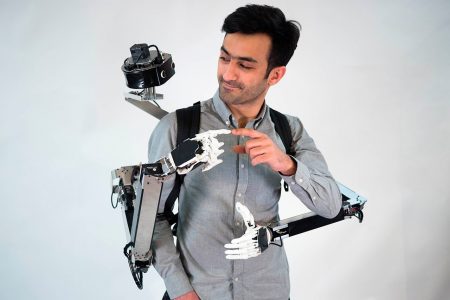August 7, 2018 – Yamen Saraiji of Keio University’s School of Media Design in Tokyo has developed a robotic set of arms that are attached to a backpack containing a personal computer controller, a wireless connection, and a battery pack with enough juice to operate for 90 minutes. The whole thing weighs under 10 kilograms (21 pounds).
He calls his extra two-armed device, Fusion. And instead of him having control of the arms, the limbs are operated remotely by someone else wearing a virtual reality (VR) headset.
The two robotic arms feature seven joints. A sort-of head containing two cameras peers over the shoulder of the wearer sending live feedback to the remote operator who sees the camera feeds in real-time. The headset wearer can sense the motion of the wearer and view the surroundings. The Fusion backpack wearer can ask for a neck massage, or for the remote operator to pick up and pass him or her an object within the viewing field of the cameras.
The headset being used is Oculus Rift. Different buttons can control individual fingers on each robotic hand providing excellent dexterity for providing precision assistance to the wearer.
What kind of applications make sense for Fusion?
Two come to mind immediately. Fusion could be a terrific assistant to spacefarers providing remote-controlled assistance during a spacewalk. And in medicine, one could imagine how a medical professional could remotely assist a novice doctor, nurse practitioner, or emergency medical assistant to do complex interventions in a medical emergency happening thousands of kilometers away.
Currently Saraiji is pitching the product to a Tokyo-based startup accelerator to get funding to turn Fusion into a commercially available product.









